|
PART ONE
THE OLD MODELS DON'T WORK
DARWINISM AND CREATIONISM UNDER FIRE
1 - Darwin's Demise
On the Futile Search for Missing Links
Will Hart
Charles Darwin was a keen observer of nature and an original
thinker. He revolutionized biology.
Karl
Marx was also an astute observer of human society and an original
thinker. He revolutionized economic and political ideology. They
were contemporary nineteenth-century giants who cast long shadows
and subscribed to the theory of "dialectical materialism" - the
viewpoint that matter is the sole subject of change and all change
is the product of conflict arising from the internal contradictions
inherent in all things.
And yet, as much appeal as dialectical
materialism had to the intellectuals and working classes of certain
countries, by the close of the last century it had failed to pass
the test in the real world.
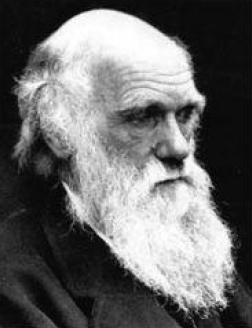
Charles Darwin
(PHOTOGRAPH BY BENJAMIN CUMMIN'GS)
Darwinism is beginning to show similar signs of strain and fatigue.
It is not just creationists who are sounding the death knell.
Darwin
was well aware of the weaknesses of his theory. He called the origin
of flowering plants "an abominable mystery." That mystery remains
unsolved to this day.
As scientists have searched the fossil record assiduously for more
than one hundred years for the "missing link" between primitive
nonflowering and flowering plants without luck, a host of other
trouble spots have flared up. Darwin anticipated problems should
there be an absence of transitional fossils (chemically formed
duplications of living creatures).
At the time, he wrote:
"It is the
most serious objection that can be urged against the theory."
However, he could not have predicted where additional structural
cracks would appear and threaten the very foundation of his theory.
Why? Biochemistry was in an embryonic state in Darwin's day. It is
doubtful that he could have imagined that the structure of DNA would
be discovered in less than one hundred years from the publication of
Origin of Species.
In a twist of fate, one of the first torpedoes to rip holes in the
theory of evolution was unleashed by a biochemist. In Darwin's Black
Box: The Biochemical Challenge to Evolution, Michael Behe, a biology
professor, points to a strange brew bubbling in the test tube.
He
focuses on five phenomena: blood clotting, cilia, the human immune
system, the transport of materials within cells, and the synthesis
of nucleotides. He analyzes each phenomenon systemically and arrives
at a single startling conclusion: These are systems that are so
irreducibly complex that no gradual, step-by-step Darwinian route
could have led to their creation.
The foundation of Darwin's theory is simple, perhaps even
simplistic. Life on Earth has evolved through a series of biological
changes as a consequence of random genetic mutations working in
conjunction with natural selection. One species gradually changes
over time into another.
And those species that adapt to changing
environmental conditions are best suited to survive and propagate
and the weaker die out, producing the most well-known principle of
Darwinism - survival of the fittest.
The theory has been taught to children for generations. We have all
learned that fish changed into amphibians, amphibians became
reptiles, reptiles evolved into birds, and birds changed into
animals. However, it is far easier to explain this to schoolchildren
- with cute illustrations and pictures of a lineup of apes
(beginning with those having slumped shoulders, transitioning to two
that are finally standing upright) - than it is to prove.
Darwinism is the only scientific theory taught worldwide that has
yet to be proved by the rigorous standards of science. Nevertheless,
Darwinists claim that Darwinism is no longer a theory, but rather an
established scientific fact. The problem is not a choice between
biblical creation and evolution.
The issue to resolve boils down to
a single question: Has Darwin's theory been proved by the rules of
scientific evidence?
Darwin knew that the only way to verify the main tenets of the
theory was to search the fossil record. That search has continued
since his day. How many paleontologists, geologists, excavators,
construction workers, oil- and water-well drillers, archeologists
and anthropologists, students and amateur fossil hunters have been
digging holes in the ground and discovering fossils from Darwin's
day until today? Untold millions.
What evidence has the fossil record revealed concerning Darwin's
transitional species?
The late Harvard biologist Stephen Jay Gould,
the antithesis of a Bible-thumping creationist, acknowledged:
"All
paleontologists know that the fossil record contains precious little
in the way of intermediate forms; transitions between major groups
are characteristically lacking."
Notice he didn't say that there is a dearth of fossils - just of
the ones that are needed to substantiate
Darwin's theory.
There are
plenty of fossils of ancient forms and plenty of newer ones. For
example, we find fossils of early and extinct primates, hominids,
Neanderthals and Homo sapiens, but no fossils of the transition
linking ape and man. We find a similar situation with Darwin's
dreaded appearance of flowering plants, his Achilles' heel.
Water deposits in the ancient past have left millions of fossils in
a vast geologic library. Why do we find representative non-flowering
plants from three hundred million years ago and flowering plants
from one hundred million years ago still alive today but no plants
showing the gradual process of mutations that represent the
intermediate species that (should) link the two?
There are no such plants living today. nor are they found in the
fossil record. That is Darwin's cross.
This is a serious. even critical issue that needs deep and thorough
analysis. In an interview about his penetrating critique, Facts of
Life: Shattering the Myth of Darwinism, the science journalist
Richard Milton describes what made him write the book:
"It was the
absence of transitional fossils that first made me question Darwin's
idea of gradual change. I realized. too. that the procedures used to
date rocks were circular. Rocks are used to date fossils; fossils
are used to date rocks. From here I began to think the unthinkable:
Could Darwinism be scientifically flawed?"
Milton makes it clear that he does not support those who attack
Darwin because they have a religious ax to grind:
"As a science
journalist and writer with a lifelong passion for geology and
paleontology - and no religious beliefs to get in the way - I
was in a unique position to investigate and report on the state of
Darwin's theory in the 1990s." he said. "The result was unambiguous.
Darwin doesn't work here any more."
According to Milton, who had been a firm Darwinist, when he began to
rethink the theory, he became a regular visitor to Great Britain's
prestigious Natural History Museum.
He put the best examples that
Darwinists had gathered over the years under intense scrutiny. One
by one they failed to pass the test. He realized that many
scientists around the world had already arrived at the same
conclusion. The emperor was as naked as an ape.
Why had no one gone
public with papers critiquing the theory?

Darwin*$ exploratory ship, the Beagle,
beached for repairs in New
Zealand
What trained, credentialed scientist earning a living through a
university or government position wants to jeopardize a career and
earn the disdain of colleagues in the process? Apparently none.
Rocking the boat is never popular. The HMS Beagle is still afloat
and it appears to be buttressed by a Darwinist army that is every
bit as dogmatic about its beliefs as are the creationists, who,
Darwinists complain, have a religious, nonscientific agenda.
Scientists have dropped hints, however. During a college lecture in
1967, the world-renowned anthropologist Louis B. Leakey was asked
about "the missing link."
He replied tersely,
"There is no one link
missing - there are hundreds of links missing."
Gould eventually wrote a paper proposing a theory to try to explain
the lack of transitional species and the sudden appearance of new
ones. He called this theory "punctuated equilibrium."
The public is not generally well informed about the scientific
problems associated with Darwin's theory of evolution. And while the
average person is aware that there is a war going on between
creationists and evolutionists. that is seen as a rear-guard action.
an old battle between science and religion over matters that the
Scopes trial settled more than a generation ago.
And there is some
consternation over "the missing link" between apes and man.
The true believers among Darwinists have long been puzzled by the
lack of transitional fossils. The reasoning goes something like
this: They must be out there hidden in the record somewhere. How do
we know this? Darwin's theory demands it! So the search goes on.
But
just how long a time and how many expeditions and how many years of
research are needed before they finally admit that there must a good
reason that the transitional fossils are not there?
Critics contend that the reason for the lack of transitional fossils
is simple: Darwin's theory fails to meet the rigorous scientific
criteria for proof because it is fatally flawed. The main tenets did
not predict what has proved to be the outcome of more than a hundred
years of research: missing links instead of transitional species.
Darwin knew the flak would come should the fossil record not contain
the necessary transitional species.
Geneticists have long known that the vast majority of mutations are
either neutral or negative. In other words. mutations are usually
mistakes. failures of the DNA to accurately copy information. It
would appear that this is not a very reliable primary mechanism and
it needs to be. because natural selection is obviously not a dynamic
force that could drive the kinds of changes that evolutionists
attribute to the theory.
Natural selection operates more like a control mechanism. a feedback
system that weeds out poor adaptations and selects successful ones.
The problem with mutation being the driving force is several-fold.
As Behe pointed out in his book. life within a cell is just too
complex to be the outcome of random mutations. But Darwin didn't
have the kind of lab technology that molecular biologists today have
at their disposal. Darwin was working with species. not the
structure of cells. mitochondria. and DNA. But the mutation theory
doesn't work well on other levels. either.
Now we must return to the problem of the sudden appearance of
flowering plants. There is a high degree of organization in flowers.
Most flowers are specifically designed to accommodate bees and other
pollinators. Which came first. the flower or the bee?
We'll get to
that momentarily; the first question is: How did the alleged
primitive non-flowering plant, which had for eons relied on asexual
reproduction, suddenly grow the structures required for sexual
reproduction?
According to Darwin's theory. it happened when a gymnosperm mutated
and then changed over time into a flowering plant. Is that possible?
Let's keep a few facts in mind: In flowering plants. the transfer of
pollen from the male anther to the female stigma must occur before
seed plants can reproduce sexually.
The mutation had to start with
one plant, somewhere. at some point. There were no insects or
animals specifically adapted to pollinate flowers because there were
no flowers prior to that time.
This is where the idea of combining mutation, natural selection, and
gradualism breaks down. When faced with the dilemma of advanced
organization and the leap from asexual reproduction to sexual
reproduction, Darwinists will say that evolution simply operates too
slowly for the links to be apparent. That is a non sequitur. If it
acts slowly, then there should be a superabundance of fossils
demonstrating the existence of the missing links.
Natural selection would not select a gymnosperm (let's say a fern)
that suddenly mutated a new structure that required an enormous
amount of the plant's energy but had no purpose. In other words,
flowerless plants could not have gradually grown the flower parts in
a piecemeal fashion over tens of millions of years until a fully
functional flower head was formed.
That would go against Darwin's
own law of natural selection, the survival of the fittest.
The more you isolate the logical steps that had to occur for
Darwin's theory to be correct, the more trouble you get into.
How
would a newly evolved flower propagate without other flowers nearby?
Why do we find numerous examples of gymnosperms and angiosperms in
the fossil record but no transitional species to demonstrate how
mutation and natural selection operated to create flowers?
If Darwinism cannot explain the mechanisms responsible for
speciation and how life on this planet evolves, what can? Sir
Francis Crick, the codiscover of DNA's double helix structure,
proposed the
concept of "panspermia," the idea that life was brought
to Earth by an advanced civilization from another planet. It is
obvious that Crick was not sold on Darwinism.
Behe ends his book
with an argument for integrating a "theory of intelligent design"
into mainstream biology.
Other biologists, like Lynn Margulis, think that Darwinism leans too
heavily on the idea that competition is the main, driving force
behind survival. She points out that cooperation is as readily
observed and as important, perhaps more important.
Nature contains
many examples of symbiosis: Flowers need bees and vice versa.
Another example is the relationship between mycorrhizal fungi and
forest trees. There are bacteria that fix nitrogen for plants. The
list goes on.
What is a human body but a collection of different
kinds of cells and viruses working together to create a complex
organism?
The old paradigm is starting to give way to new thinking and new
models such as intelligent design and extraterrestrial intervention.
Marx and Freud were nineteenth-century pioneers who blazed trails,
but so was Newton.
Their new paradigms inspired new perspectives and
they solved old problems. Still, they had their limits. Their
theories were mechanistic and materialistic. Newton's decline came
with the introduction of Einstein's theory of relativity. The new
paradigm of the laws of physics fit the facts and
answered more questions. and that meant it had greater utility. Is
Darwin next?
Until a more comprehensive theory of how life originated, changed,
and continues to evolve emerges, as Richard Milton put it.
"Darwin
doesn't work here anymore."
2 - Evolution vs. Creation
Is the Debate for Real?
David Lewis
Genesis. the biblical story of creation. tells us that God created
the universe in six days. He made Adam.
the first man. the Bible tells us. from the dust of the earth. an
event many Christians believe took place in the Garden of Eden six
thousand years ago. Scientists and religious scholars call this
scenario "creationism."
In 1859. Charles Darwin came up with another idea. He said man's
existence could be explained within the context of material creation
alone. through evolution and natural selection - that is. "the
survival of the fittest."
According to Darwin. man evolved from the
apes. an idea distinctly at odds with the biblical scenario.
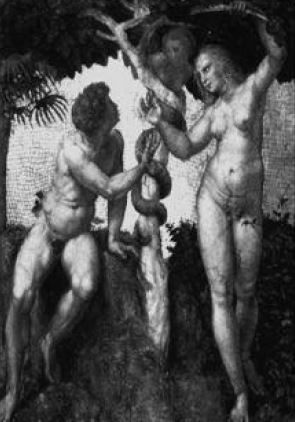
Adam and Eve,
by Raphael
The debate over human origins has raged ever since. It surfaced
recently in Abbotsford, British Columbia, where a school board
dominated by Christians requires the teaching of "intelligent
design," a form of creationism, along with the theory of evolution.
Reports Maclean's magazine.
"The issue they are debating is a large
one... arguably the biggest question of them all: how did life
begin... with a Big Bang or a Big Being?"
Critics of the Abbotsford policy fear the school board would place
the Book of Genesis on a par with Darwin's Origin of Species.
They
accuse the board of imposing their religious beliefs on students.
while some Christians believe that teaching Darwinism amounts to the
same thing. the imposition of a de facto religious belief system.
Recent studies show. however. that adherents to both sides of this
wrangle would do well to rethink their positions. A reexamination of
old and new research reveals that the creationism-versus-Darwinism
debate may be missing the mark entirely.
Richard Thompson and Michael Cremo, coauthors of
Forbidden
Archeology (and its condensed version,
The Hidden History of the
Human Race), have assembled a body of evidence that testifies to the
existence of modern man millions of years before his supposed
emergence from southern Africa 100.000 years ago.
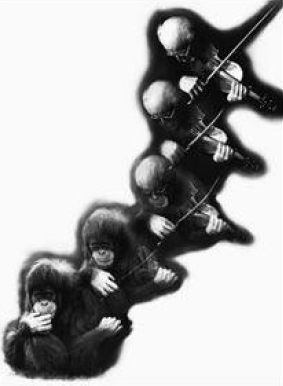
Evolution
(AftT ErV TOM Mll.T.KR)
On "The Mysterious Origins of Man," an NBC documentary that aired in
February of 1996.
Thompson and Cremo make their case along with
other experts. The evidence they reveal suggests man neither evolved
from apes nor rose from the dust of the earth just four thousand
years before the time of Christ. The implications are profound and
may force a reevaluation of the entire issue of human origins.
Narrated by Charlton Heston and drawing on evidence largely ignored
by the scientific establishment. "The Mysterious Origins of Man"
steps outside the usual Bible-versus-Darwin debate. At issue are
human footprints discovered in Texas. side by side with dinosaur
tracks; stone tools dating back fifty-five million years;
sophisticated maps of unknown antiquity; and evidence of advanced
civilization in prehistory.
Based on research assembled as Darwin began to dominate scientific
thought at the turn of the nineteenth century. and also upon more
recent archeological discoveries.
"The Mysterious Origins of Man"
exposes a "knowledge filter" within the scientific establishment. a
bias that favors accepted dogma while rejecting evidence that does
not support conventional theory.
As a result. fossil evidence indicating that man is far more ancient
than conventional theory allows. and that he did not evolve from
apes. has gathered dust for over a century. It has been suppressed.
in effect. because it conflicts with an entrenched belief system.
the NBC documentary reveals. Moreover. scientists who challenge
accepted dogma can find themselves not only on the outside of the
debate. but also unemployed.
Thompson. the science investigator Richard Milton. and other experts
trace the problem to "speculative leaps" made by researchers too
eager to find the missing link in human evolution. the
long-sought-after ancestor of both man and apes.
"It seems any
missing link will do," Milton says, regarding the 120-year effort to
prove Darwin's theory.
In the case of the so-called pithecanthropus ape-man (aka Java Man,
Homo erectus), the anthropologist Eugene Dubois found, in Indonesia,
a human thighbone and the skullcap of an ape separated by a distance
of forty feet.
The year was 1891. He pieced the two together,
creating the famous Java Man. But many experts say the thighbone and
skullcap are unrelated. Shortly before his death, Dubois himself
said the skullcap belonged to a large monkey and the thighbone to a
man. Yet Java Man remains to this day, to many, evidence of man's
descent from the apes, having been featured as such in New York's
Museum of Natural History until 1984.
In the case of Piltdown Man, another missing link wannabe, this one
"discovered" in England in 1910, the find proved to be a
sophisticated fraud perpetrated, in all likelihood, by overly
zealous Darwinists. And even the crown jewel of alleged human
ancestral fossils, the famous "Lucy," found in Ethiopia in 1974, is
indistinguishable from a monkey or an extinct ape, according to many
anthropologists.
The physical anthropologist Charles Oxnard and other scientists have
drawn a picture of human evolution that is radically at odds with
the conventional theory, a fact usually ignored by universities and
natural history museums.
Oxnard placed the genus Homo, to which man
belongs, in a far more ancient time period than standard
evolutionary theory allows, bringing into question the underpinnings
of Darwin's theory.
As reported in Cremo and Thompson's Forbidden
Archeology, Oxnard says,
"The conventional notion of human evolution
must now be heavily modified or even rejected... new concepts
must be explored."
What pains other opponents of standard evolutionary theory is its
inability to account for how new species and features originate -
the supposition that the innumerable aspects of biological life,
down to the pores in human skin, and a beetle's legs, and the
protective pads on a camel's knees, came about accidentally through
natural selection.
The notion of intent, or inherent purpose, within
creation does not fit in to the Darwinian version of reality.
Life, to a Darwinist, can exist only in the context of absolute
materialism: a series of accidental events and chemical reactions
that are responsible for everything in the universe.
Even common
sense seems to take a backseat to scientific dogma. In the case of
the human brain, for instance, its advanced capacities (the ability
to perform calculus, play the violin, even consciousness itself)
cannot be explained by the "survival of the fittest" doctrine alone.
WHAT ABOUT THE BIBLE AND CREATIONISM?
The creationist argument derives from orthodox religious doctrine,
rejecting allegorical and metaphorical interpretations of the Book
of Genesis.
It is a belief system many Christians do not accept
literally and which the Bible itself may not support. It also lacks
scientific support, in that fossil records reveal that man has
existed on Earth for far longer than six thousand years.
The six
days of creation scenario, moreover, taken literally, bears no
resemblance to the time it took for the universe to be born.
The more commonsense notion of intelligent design (creationism
without the dogma) strikes a more palatable note, even among some
scientists who find it hard to deny that an inherent intelligence
exists within the universe.
The problem with creationism lies, then,
not in the idea of intelligent design, but in its dogmatic and
inflexible interpretations of the Bible with regard to the debate
over human origins.
NEW GROUND OR ANCIENT WISDOM?
Evidence for extremely ancient human origins will lead many into
foreign territory, terrain some would rather avoid.
But to others,
the standard creationism versus evolution debate was wanting all
along. Once looked upon with raised eyebrows, and still facing
dogged opposition, the "catastrophist" point of view has made
headway of late in the scientific community. This theory holds that
sudden disruptions in the continuity of planetary life have taken
place, altering the course of evolution. ("Gradualism," on the other
hand, a Darwinist tenet that assumes all life evolved slowly and
without interruption, has fallen out of favor in some circles.)
Indeed, it has become clear that all sorts of catastrophes have
taken place on the globe and in the universe at large. A well-known
catastrophist theory proposes that the extinction of the dinosaurs
resulted from a huge meteor crashing into the planet with the force
of thousands of hydrogen bombs. Other catastrophic theories have to
do with drastic changes in climate, seismic upheavals and
fluctuations, and even reversals in Earth's magnetic field.
The catastrophism versus gradualism debate, while revealing how
little science knows for certain about prehistory, also exposes a
distinct prejudice within the scientific community - an antipathy,
dating to the time of Darwin, toward anything remotely resembling
biblical catastrophes such as the Great Flood, even if the
connection has to do only with sudden rather than gradual changes in
the course of evolution.
Catastrophism, though, avails another scenario regarding human
origins and prehistory.
As presented in Graham Hancock's
Fingerprints of the Gods - The Evidence of Earth's Lost Civilization
and in Rand and Rose Flem-Ath's When the Sky Fell: In Search of
Atlantis, a sudden, catastrophic shifting of the earth's
lithosphere, called "crustal displacement," may have occurred at
some time in the past.
Lent credibility by Albert Einstein, the
theory suggests that the earth's outer crust may have suddenly (not
gradually, as in continental drift) shifted on the surface of the
globe, causing continents to slide into radically different
positions.
Drawing on the work of Charles Hapgood, who developed the theory
with Einstein's assistance, the Flem-Aths explain that this may be
the reason carcasses of hundreds of woolly mammoths, rhinos, and
other ancient mammals were found flash-frozen in a "zone of death"
across Siberia and northern Canada.
Remarkably, the stomachs of
these mammals contained warm-weather plants, the implication being
that the very ground upon which the animals grazed suddenly shifted
from a temperate to an arctic climate. Hapgood and Einstein
theorized that a sudden shifting and freezing of the continent of
Antarctica, which may have been situated two thousand miles farther
north than it is now, could have occurred as a result of crustal
displacement.
Ancient maps accurately depicting Antarctica before it was covered
in ice also support the idea that the continent was situated in a
temperate climate in recent prehistory.
Copied from source maps of
unknown antiquity, the
Piri Ri'is, Oronteus Finaeus, and Mercator
maps derive, Graham Hancock and the Flem-Aths propose, from some
prehistoric society with the capacity to calculate accurately
longitude and chart coastlines, an accomplishment that did not take
place in recorded history until the eighteenth century.
As outlined in the Flem-Aths' and Hancock's books, the maps, along
with a body of evidence, testify
to the existence of a sophisticated prehistoric civilization.
Charlton Heston. narrating NBC's "The Mysterious Origins of Man."
likens this scenario to Plato's description of the lost continent of
Atlantis.
LOST CIVILIZATIONS. THE REAL MISSING LINK?
Examining stonework at ancient cites in Bolivia, Peru, and Egypt,
Hancock argues that these megalithic marvels could not have risen
from the dust of nomadic hunter-gatherers, which is what
conventional science would have us believe.
The magnificent
city of
Tiahuanaco, Bolivia, said by the Bolivian scholar
Arthur Poznansky
to date to 15.000 B.C.E.. emerges as a case in point. Precision
stone cuttings performed on immense blocks at Tiahuanaco. and at the
other sites. to tolerances of one fiftieth of an inch. and then the
transporting of these blocks over long distances. reveal technical
capabilities that match or surpass those of modern engineers.
How supposedly primitive people transported these megaliths to the
summit of Machu Picchu in Peru, for instance. remains a great
mystery and is a feat that conventional science is at a loss to
explain.
Hancock asserts that even if we accept the later dates most
archeologists ascribe to these structures, the knowledge and
technical abilities of the builders would had to have been the
product of a civilization that evolved over a long period of time,
pushing the appearance of civilized man to the predawn of recorded
history.
"My view," Hancock says, "is that we are looking at a common
influence that touched all of these places. long before recorded
history. a remote third-party civilization yet to be identified by
historians."
A wide range of natural evidence and recorded human experience
points to the existence of such a civilization.
Etymology. the study
of word origins. postulates that a prehistoric Indo-European
language must have existed to account for the deep similarities in
the world's languages. Could this have been the language of
Hancock's prehistoric civilization?
Hamlet's Mill: An Essay Investigating the Origins of Human Knowledge
and Its Transmission through Myth, written by M.I.T. professor of
science Giorgio de Santillana and University of Frankfurt professor
of science Hertha von Dechend. is a study of how ancient myths
depict the procession of the equinoxes. As such. it weighs in on
this common-language issue also. testifying to the existence of
advanced knowledge proliferated among prehistoric peoples.
Discussing myths that originate in the mists of antiquity. and the
numerical values and symbology recorded therein. Santillana and von
Dechend reveal that the ancients of many cultures shared a
sophisticated knowledge of celestial mechanics. knowledge that has
been matched only recently. with the help of satellites and
computers.
The proliferation of closely related biological species on
continents separated by vast oceans. a phenomenon that puzzles
Darwinists. can also be explained by the existence of an advanced.
seafaring civilization in prehistory. An entire body of evidence. in
fact. supports man and civilization having existed at a far earlier
date than orthodox science or religion concedes is the case.
Could
the existence. then. of such a civilization be the real missing link
in human history?
WHY LIMIT THE DEBATE TO WESTERN MODELS?
The conventional debate over our origins. as we find it
characterized in the major media. ignores concepts of human and
cosmic origins that are shared by a large portion of the world's
population: those of the mystic East.
Einstein himself entertained
such ideas because they supported his belief in a universal
intelligence. More recently. the physicist and Nobel laureate Brian
Josephson and others have drawn parallels between Eastern mysticism
and modern physics.
Fritjof Capra, in
The Tao of Physics, harmonizes
Vedic, Buddhist, and Taoist philosophy with the subtleties of
quantum theory.
The Vedas. in fact. present a scenario similar to the expanding and
contracting universe of modern physics. the Great In breath and Out
breath of creation. the projection of omnipresent consciousness.
Brahman. the essence of which remains intrinsic to all things as
creation evolves. Taoism. on the other hand. offers an understanding
of conscious reality that closely resembles Heisenberg's
"uncertainty principle." wherein perspective. or consciousness.
shapes objective reality.
To Einstein. especially in his later years. the idea of
consciousness-based reality - the awareness of a universal.
conscious presence inseparable from identity and creation - became
naturally apparent. as it does now to others in the fields of
physics. philosophy. and religion.
"As I grow older." Einstein said.
"the identification with the here and now [his famous space-time] is
slowly lost. One feels dissolved. merged into nature."
The greatest minds. then. of our time and of the greatest antiquity
reject Darwin's often unstated premise. his belief in absolute
materialism. which holds that all life evolved from primitive
matter. accidentally. without purpose or design.
At the same time.
consciousness-based creation offers an alternative to strict
biblical interpretations and the concept of an anthropomorphic
creator separate from man and nature.
Establishment science. though. has had a hands-off approach to
consciousness. never daring to explore what. by definition. cannot
be explained by matter-based beliefs about the origins of life.
An
article by David Chalmers. in the December 1995 issue of Scientific
American, "The Puzzle of Conscious Experience." emphasizes the
point.
"For many years." Chalmers says. "consciousness was shunned by
researchers... The prevailing view was that science. which depends
on objectivity. could not accommodate something as subjective as
consciousness."
Chalmers goes on to say that neuroscientists.
psychologists. and philosophers are only recently beginning to
reject the idea that consciousness cannot be studied.
He proposes.
while insisting that consciousness is materially based. that,
"[it]
might be explained by a new kind of theory . . . [that] will
probably involve new fundamental laws [with] startling consequences
for our view of the universe and of ourselves."
The eminent physicist Steven Weinberg, in his book
Dreams of a Final
Theory, puts it another way.
He says the goal of physics is to
develop a "theory of everything" that will tell us all there is to
know about the universe - a law or principle from which the universe
derives. So stating, Weinberg exposes the limitations of scientific
materialism, while at the same time trying to transcend it, as he
butts up against an Absolute, a Logos, if you will, that cannot
exist within the context of matter-based creation.
The real problem,
he admits, is consciousness, because it is beyond what could have
derived from material processes alone.
Darwinism, therefore, which depends upon the assumption that all
existence is matter-based, cannot account for the most human
characteristic of all, consciousness, which cannot derive from the
process of natural selection in a random, mechanistic creation - the
capacity of the human mind being far beyond what is necessary for
mere survival. And strict creationism, when pitted against a
Darwinism that ignores the origin of consciousness along with other
crucial factors, appears to be merely a foil that Darwinists use to
make themselves look good.
To understand human origins, then, and to develop a "theory of
everything," a true scientist must not only evaluate the tangible
evidence presented in Forbidden Archeology and in Hancock's
Fingerprints of the Gods, he also must study consciousness, without
which he neglects the most basic capacity of human beings - the
ability to think creatively. He would have to experiment in the
internal, subjective world, delving into what the scientific
establishment considers a forbidden realm.
He would have to devote
himself, independent of any dogma, to the essence of his own
conscious existence, as well as to the study of material creation.
Like Einstein, he would see this pursuit as the essential goal of
both science and religion, the search for knowledge in its purest
sense, or sciere in the Latin, from which the word science derives.
By so doing, science might arrive at a theory of everything.
3 - Exposing a Scientific Cover-Up
Forbidden Archeology Coauthor Michael Cremo Talks about the
"Knowledge Filter" and Other Means for Cooking the Academic Books
J. Douglas Kenyon
In 1966. respected archeologist Virginia Steen-McIntyre and her
associates on a U.S. Geological Survey
team. working under a grant from the National Science Foundation.
were called upon to date a pair of remarkable archeological sites in
Mexico.
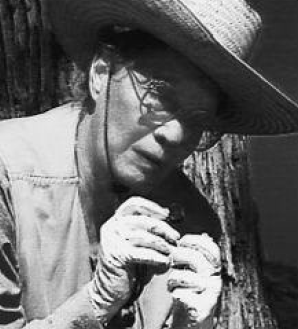
Virginia Steen-McIntyre
Sophisticated stone tools rivaling the best work of
Cro-Magnon man in Europe had been
discovered at Hueyatlaco, while
somewhat cruder implements had been turned up at nearby El Horno.
The sites. it was conjectured. were very ancient. perhaps as old as
20.000 years. which. according to prevailing theories. would place
them very close to the dawn of human habitation in the Americas.
Steen-McIntyre. knowing that if such antiquity could indeed be
authenticated her career would be made. set about an exhaustive
series of tests. Using four different but well-accepted dating
methods. including uranium series and fission track. she determined
to get it right. Nevertheless. when the results came in. the
original estimates proved to be way off. Way under, as it turned
out.
The actual age of the sites was conclusively demonstrated to be
more like a quarter of a million years!
As we might expect. some controversy ensued. Steen-McIntyre's date
not only challenged accepted chronologies for human presence in the
region. but also contradicted established notions of how long modern
humans could have been anywhere on Earth.
Nevertheless. the massive
reexamination of orthodox theory and the wholesale rewriting of
textbooks that one might logically have expected did not ensue. What
did follow was the public ridicule of Steen-McIntyre's work and the
vilification of her character. She has not been able to find work in
her field since.
More than a century earlier. following the discovery of gold in
California's Table Mountain and the subsequent digging of thousands
of feet of mining shafts. miners began to bring up hundreds of stone
artifacts and even human fossils.
Despite their origins in
geological strata documented at nine to fifty-five million years in
age, California state geologist J. D. Whitney was able subsequently
to authenticate many of the finds and to produce an extensive
report. The implications of Whitney's evidence have never been
properly answered or explained by the scientific establishment, yet
the entire episode has been virtually ignored and references to it
have vanished from the textbooks.
For decades, miners in South Africa have been turning up - from
strata nearly three billion years in age - hundreds of small
metallic spheres with encircling parallel grooves. Thus far, the
scientific community has failed to take note.
Among scores of such cases cited in Richard Thompson and Michael
Cremo's Forbidden Archeology (and in its condensed version, Hidden
History of the Human Race), it is clear that these three examples
are by no means uncommon.
Suggesting nothing less than a "massive
cover-up," Cremo and Thompson believe that when it comes to
explaining the origins of the human race on Earth, academic science
has cooked the books.
Though the public may believe that all the real evidence supports
the mainstream theory of evolution - with its familiar
timetable for human development (i.e., Homo sapiens of the modern
type go back only about 100,000 years) - Cremo and Thompson
demonstrate that, to the contrary, a virtual mountain of evidence
produced by reputable scientists applying standards just as
exacting, if not more so, than those of the establishment has been
not only ignored but, in many cases, actually suppressed.
In every
area of research, from paleontology to anthropology and archeology,
that which is presented to the public as established and irrefutable
fact is indeed nothing more, says Cremo,
"than a consensus arrived
at by powerful groups of people."
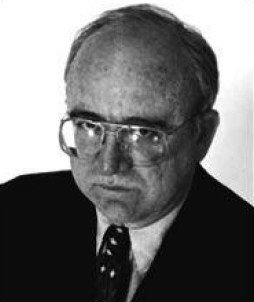
Michael Cremo
Is that consensus justified by the evidence? Cremo and Thompson say
no.
Carefully citing all available documentation, the authors produce
case after case of contradictory research that has been conducted in
the last two centuries. The authors describe astonishing discoveries
made, and then go on to discuss the controversies that ensued from
those discoveries and the suppression of evidence that invariably
followed.
Typical is the case of George Carter, who claimed to have found, at
an excavation in San Diego, California, hearths and crude stone
tools at levels corresponding to the last interglacial period, some
80,000-90,000 years ago.
Even though Carter's work was endorsed by
some experts such as the lithic scholar John Witthoft, the
establishment scoffed. San Diego State University refused to even
look at the evidence in its own backyard and Harvard University
publicly defamed Carter in a course entitled "Fantastic Archeology."
What emerges is a picture of an arrogant and bigoted academic elite
interested more in the preservation of its own prerogatives and
authority than the truth.
Needless to say, the weighty (952-page) volume, Forbidden
Archeology, has caused more than a little stir. The establishment,
as one might expect, is outraged, but it is having a difficult time
ignoring the book.
The anthropologist Richard Leakey wrote,
"Your
book is pure humbug and does not deserve to be taken seriously by
anyone but a fool."
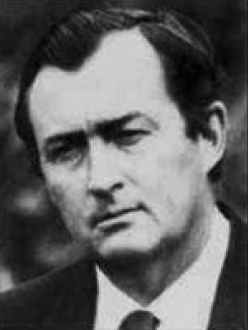
Richard Leakey
Nevertheless, many prestigious scientific publications, including
The American Journal of Physical Anthropology, Geo Archeology, and
the British Journal for the History of Science, have deigned to
review the book.
While generally critical of its arguments, they
have conceded, although grudgingly, that Forbidden Archeology is
well written and well researched, and some indeed recognize a
significant challenge to the prevailing theories.
As William Howells wrote in Physical Anthropologist,
"To have modern
human beings... appearing a great deal earlier, in fact at a time
when even simple primates did not exist as possible ancestors, would
be devastating, not only to the accepted pattern, it would be
devastating to the whole theory of evolution, which has been pretty
robust up until now."
Yet despite its considerable challenge to the evolutionary edifice,
Forbidden Archeology chooses not to itself with the familiar
creationist point of view, nor to attempt an alternative theory of
its own.
The task of presenting his own complex theory - which
seeks, Cremo says, to avoid the "false choice" between evolution and
creationism usually presented in the media - Cremo has undertaken in
another book, entitled Human Devolution.
On the question of human
origins, he insists,
"We really do have to go back to the drawing
board."
As the author told Atlantis Rising recently:
'"Forbidden Archeology'
suggests the real need for an alternative explanation, a new
synthesis. In Human Devolution, I've gone into that in detail. It's
got elements of the Darwinian idea, and elements of the ancient
astronaut theory, and elements of the creationist nature, but it's
much more complex.
I think we've become accustomed to overly
simplistic pictures of human origins, whereas the reality is a
little more complicated than any advocates of the current ideas are
prepared to admit.”
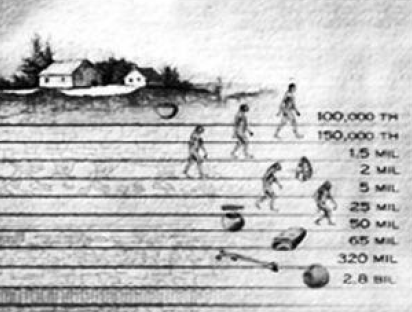
Time line of
anomalous artifacts
Both Cremo and Thompson are members of the Bhaktivedanta Institute -
the Science Studies Branch of the International Society for Krishna
Consciousness.
Cremo and Thompson started their project with the
goal of finding evidence to corroborate the ancient Sanskrit
writings of India. which relate episodes of human history going back
millions of years.
"So we thought," says Cremo, "if there's any truth to those ancient
writings. there should be some physical evidence to back it up. but
we really didn't find it in the current textbooks."
They didn't stop
there, though.
Over the next eight years. Cremo and Thompson
investigated the entire history of archeology and anthropology.
delving into everything that has been discovered. not just what has
been reported in textbooks.
What they found was a revelation.
"I
thought there might be a few little things that have been swept
under the rug," said Cremo, "but what I found was truly amazing.
There's actually a massive amount of evidence that's been suppressed."
Cremo and Thompson determined to produce a book of irrefutable
archeological facts.
"The standard used." says Cremo. "[meant] the
site had to be identifiable. there had to be good geological
evidence on the age of the site. and there had to be some reporting
about it. in most cases in the scientific literature."
The quality
and quantity of the evidence - they hoped - would compel serious
examination by professionals in the field. as well as by students
and the general public.
Few would deny that they have succeeded in spectacular fashion. Much
in demand in alternative science circles. the authors have also
found a sympathetic audience among the self-termed sociologists of
scientific knowledge. who are very aware of the failure of modern
scientific method to present a truly objective picture of reality.
The problem. Cremo believes. is both misfeasance and malfeasance.
"You can find many cases where it's just an automatic process. It's
just human nature that a person will tend to reject things that
don't fit in with his particular worldview." he said.
He cites the example of a young paleontologist and expert on ancient
whalebones at the Museum of Natural History in San Diego.
When asked
if he ever saw signs of human marks on any of the bones. the
scientist remarked.
"I tend to stay away from anything that has to
do with humans because it's just too controversial."
Cremo sees the response as an innocent one from someone interested
in protecting his career. In other areas, though, he perceives
something much more vicious, as in the case of Virginia
Steen-McIntyre.
"What she found was that she wasn't able to get her
report published. She lost the teaching position at the university.
She was labeled a publicity seeker and a maverick in her profession.
And she really hasn't been able to work as a professional geologist
since then."
In other examples Cremo finds even broader signs of deliberate
malfeasance.
He mentions the activities of the Rockefeller
Foundation, which funded Davidson Black's research at Zhoukoudian,
in China. Correspondence between Black and his superiors with the
foundation shows that research and archeology were part of a far
larger biological research project.
The following is a quote from
that correspondence:
"...thus we may gain information about our
behavior of the sort that can lead to wide and beneficial control."
In other words, this research was being funded with the specific
goal of control. "Control by whom?" Cremo wants to know.
The motive to manipulate is not so difficult to understand.
"There's
a lot of social power connected with explaining who we are and what
we are," Cremo says.
"Somebody once said 'Knowledge is power.' You
could also say 'Power is knowledge.' Some people have particular
power and prestige that enables them to dictate the agenda of our
society. I think it's not surprising that they are resistant to any change."
Cremo agrees that scientists today have become a virtual priest
class, exercising many of the rights and prerogatives that their
forebears in the industrial-scientific revolution sought to wrest
from an entrenched religious establishment.
"They set the tone and
the direction for our civilization on a worldwide basis," he says.
"If you want to know something today, you usually don't go to a
priest or a spiritually inclined person, you go to one of these
people because they've convinced us that our world is a very
mechanistic place, and everything can be explained mechanically by
the laws of physics and chemistry, which are currently accepted by
the establishment."
To Cremo, it seems the scientists have usurped the keys of the
kingdom and then failed to live up to their promises.
"In many ways
the environmental crisis and the political crisis and the crisis in
values is their doing," he says.
"And I think many people are
becoming aware that [the scientists] really haven't been able to
deliver the kingdom to which they claimed to have the keys. I think
many people are starting to see that the worldview they are
presenting just doesn't account for everything in human experience."
For Cremo, we are all part of a cosmic hierarchy of beings, a view
for which he finds corroboration in world mythologies:
"If you look
at all of those traditions, when they talk about origins they don't
talk about them as something that occurs just on this planet. There
are extraterrestrial contacts with gods, demigods, goddesses,
angels."
And he believes there may be parallels in the modern UFO
phenomenon.
The failure of modern science to satisfactorily deal with UFOs,
extrasensory perception, and the paranormal provides one of the
principle charges against it.
"I would have to say that the evidence
of such today is very strong," he argues.
"It's very difficult to
ignore. It's not something that you can just sweep away. If you were
to reject all of the evidence for UFOs, abductions, and other kinds
of contacts, coming from so many reputable sources, it seems we have
to give up accepting any kind of human testimony whatsoever."
One area where orthodoxy has been frequently challenged is in the
notion of sudden change brought about by enormous cataclysms, versus
the "gradualism" usually conceived of by evolutionists.
Even though
it has become fashionable to talk of such events. they have been
relegated to the very distant past. supposedly before the appearance
of man. Yet some individuals. like Immanuel Velikovsky. have argued
that many such events have occurred in our past and induced a kind
of planetary amnesia from which we still suffer today.
That such catastrophic episodes have occurred and that humanity has
suffered from some great forgettings Cremo agrees:
"I think there is
a kind of amnesia that. when we encounter the actual records of
catastrophes. makes us think. oh well. this is just mythology. In
other words. I think some knowledge of these catastrophes does
survive in ancient writings and cultures and through oral
traditions.
But because of what you might call some social amnesia.
as we encounter those things we are not able to accept them as
truth. I also think there's a deliberate attempt on the part of
those who are now in control of the world's intellectual life to
make us disbelieve and forget the paranormal and related phenomena.
I think there's a definite attempt to keep us in a state of
forgetfulness about these things."
It's all part of the politics of ideas.
Says Cremo.
"It's been a
struggle that's been going on thousands and thousands of years. and
it's still going on."
Back to Contents
|







